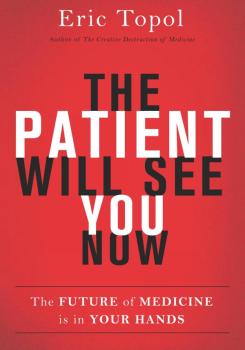A New Era of Medicine, Centered on Smartphones
An excerpt from “The Patient Will See You Now.”
The following is an excerpt from The Patient Will See You Now: The Future of Medicine is in Your Hands, by Eric Topol, M.D.
Way back in 1996, the Seinfeld TV show told the story of the “difficult” patient. Elaine Benes, played by Julia Louis-Dreyfus, developed a skin rash, but doctors kept refusing to see her. The problem was that her doctor had called her “difficult” after an appointment four years earlier, when she had not wanted to change into a gown to get a mole examined. She wanted to have her chart delete this discredit, but the doctors wouldn’t cooperate. Instead, they labeled her “very difficult.” So she worked with Kramer, who posed as Dr. Van Nostrand, to try to steal her chart. That backfired. She never got her diagnosis or chart, and even Kramer was written up in a medical record for impersonating a doctor. The segment is hilarious and at the same time sobering, since it’s a slice of medical life.
Now let’s fast-forward to two decades later. Doctors are still labeling patients as difficult. Patients are typically unable to see, let alone keep or contribute to their office visit notes about their condition and their body that they paid for. Frequently they have to consult multiple doctors for the same condition. It may take weeks to get an appointment. The time with a doctor is quite limited, typically less than ten minutes, and much of that is without eye contact because the doctor is pecking away at a keyboard.
But a new model of medicine is taking hold, one that is democratized—not difficult, but easy. If Elaine wanted to have her skin rash assessed today, all she would have to do is take a picture of it with a smartphone and download an app to process it. Within minutes, a validated computer algorithm, which is more accurate than most doctors, would deliver by text a diagnosis of her skin rash. The text would include specific next steps, perhaps treatment with a topical ointment or a visit to dermatologist for further assessment. Elaine could even download apps to see the ratings of nearby dermatologists, how expensive a visit would be, and even if the doctors themselves were difficult to deal with. When seen by a doctor, she could demand a copy of her office visit notes and also request to review and edit them (especially if she is mislabeled). Most likely, however, she wouldn’t have to see any doctor. She’d have immediate access at any moment in time, at any location, to a diagnosis of her medical condition. She would not only avoid the delay, inconvenience, and unnecessary expense, but she wouldn’t even have to find someone to steal her chart.
The difference between these two scenarios represents the essence of a new era of medicine. It is powered by unplugged digitization, with the smartphone as the hub. We have seen this model already adopted in retail, travel, dining, entertainment, banking, and virtually every other industry. It’s all on demand and instantaneously executed. This has moved far beyond just having a prosthetic brain for a search or a built-in navigation GPS. In almost any endeavor, getting things done in a flash has become the norm, except in medicine. But that is now inevitable.

Getting first-rate health care will always be quite different from ordering something from Amazon. We’re talking about the most precious part of life—one’s health—not buying a book. But the common thread is the power of information and individualization. We are embarking on a time when each individual will have all their own medical data and the computing power to process it in the context of their own world. There will be comprehensive medical information about a person that is eminently accessible, analyzable, and transferable. This will set up a tectonic (or “tech-tonic”) power shift, putting the individual at center stage. No longer will MD stand for medical deity. What have been dubbed the six most powerful words of the English language—“The doctor will see you now”—will no longer be true. Indeed you will still be seeing doctors, but the relationship will be radically altered.
The doctor will see you now via your smartphone screen without an hour of waiting, at any time, day or night. It might not be your primary care doctor, but it will be likely be a reputable physician who is conducting part of his or her practice through secure video consults. And those consults will involve doing parts of the standard physical examination remotely. More importantly, they will incorporate sharing your data—the full gamut from sensors, images, labs, and genomic sequence, well beyond an electronic medical record. We’re talking about lots of terabytes of data about you, which will someday accumulate, from the womb to tomb, in your personal cloud, stored and ready for ferreting out the signals from the noise, even to prevent an illness before it happens.
Excerpted with permission from The Patient Will See You Now: The Future of Medicine is in Your Hands, by Eric Topol. Available from Basic Books, a member of The Perseus Books Group. Copyright © 2015.
Dr. Eric Topol is the author of several books, including Deep Medicine: How Artificial Intelligence Can Make Healthcare Human Again (Basic Books, 2019) The Patient Will See You Now: The Future of Medicine is in Your Hands (Basic Books, 2015), practicing cardiologist at the Scripps Clinic, and a genomics professor at the Scripps Research Institute in La Jolla, California.